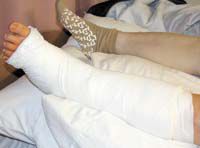| Bill Gigliotti rests after a two hour, ankle surgery. Gigliotti is one of thousands of Americans who fall and require medical attention each year. His slip up will cost him more than three weeks of bed confinement. |
With the winter reaching its coldest point, ice is a prevalent and constant fixture in Carbon County.
The frozen water found in parking lots, driveways and sidewalks poses a danger for residents of all ages. But according to a Colorado State University study, the risk of incurring serious injuries in a fall increases dramatically with age and exponentially in the elderly.
“I was just coming out of my house to get into the car like any other day,” said Price resident Bill Gigliotti. “The ground didn’t even look icy. But as I stepped off the porch and onto the sidewalk, I felt myself start slipping and then I went down.”
Gigliotti’s fall did not seem severe to him immediately after it happened and he continued with his morning routine.
But as the morning wore on, the pain in his ankle increased and the Price resident checked himself into the Castleview Hospital.
“They found a broken fibula and tibia,” sad Gigliotti. “And from there, my ankle just came apart, nuts and bolts are holding it together now and I am looking at an extended stay here at Parkdale.”
According to his physicians the 62 year-old Gigliotti is looking at three to six weeks of impatient care coupled with at least six months of intensive physical therapy following two hours of surgery.
“I will be bed ridden for at least three weeks,” said Gigliotti. “I had no idea a little fall could be this bad.”
The Colorado State study indicated that the causes of falls are known as risk factors. No single risk factor causes all falls.
But the greater the number of risk factors to which an individual is exposed, the greater the probability is the person will accidentally fall.
“Many of these risk factors are preventable,” stated the study. “Some people believe that falls are a normal part of aging and are not preventable, however, it is lack of knowledge and lack of preventative measures that result in most falls.”
According to the study, osteoporosis is the condition most related to falls injuring the elderly.
Osteoporosis is a condition wherein bones become more porous and less resistant to stress and fractures.
Osteoporosis is caused by hormonal changes, calcium and vitamin D deficiency as well as a decrease in physical activity.
Prevention tips for the disease include:
•Eating or drinking sufficient calcium. In post menopausal women the need increases to 1,500 milligrams per day.
Calcium rich foods include milk, yogurt, cheese, fish, shellfish, broccoli, soybeans, collards and turnip greens.
•Getting sufficient vitamin D in order to increase the rate of absorption into the bloodstream.
•Getting regular weight training and load bearing exercises for at least 15 minutes per day.
Failure to exercise regularly results in poor muscle tone, decreased strength and loss of bone mass and flexibility.
All of the conditions contribute to falls and the severity of injury due to the accidents, according to the study.
The remaining factors for falling among the members of aging populations residing in the Castle Valley area include:
•Impaired vision.
•Medications taken.
•Lastly and most importantly environmental hazards.
At least one-third of all falls in the elderly involve environmental hazards in the home.
The most common hazard for falls is tripping over objects on the floor.
Other factors include, poor lighting, loose rugs, lack of grab bars and unsturdy furniture.
According to the state college study, it is useful to conduct a walk-through of the home to identify possible problems that may lead to falling.
A home visit by an interior designer or occupational therapist might also be useful in that the professionals are trained to identify risk factors and recommend appropriate actions.
Regarding outdoor accidents the study recommended:
•Repairing cracks and abrupt edges of sidewalks and driveways.
•Installing handrails on stairs and steps.
•Removing high doorway thresholds and trimming shrubbery along the pathway to the home.
•Keeping walk areas clear of clutter, rocks and tools.
•Keeping walking areas clear of snow and ice.
•Installing adequate lighting by doorways and along walkways leading to doors.
Caution and prevention can decrease falling by a large margin, according to the study, which also proclaims that annually falls are reported by one-third of all people over the age of 65. And of those who fall two-thirds fall again within the next six months.
“I will most definitely look before I leap the next time,” concluded Gigliotti.

